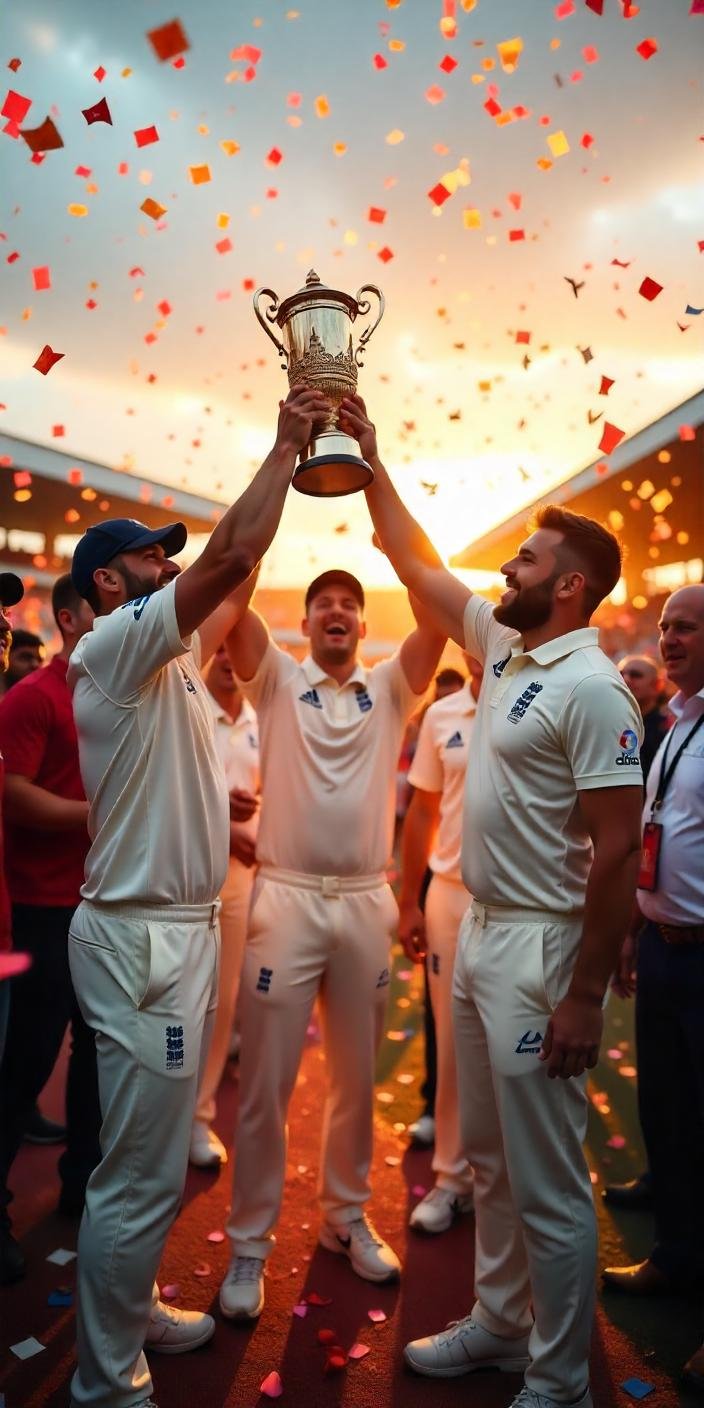
England 400-8 (50 overs): Root 57 (65), Brook 58 (45), Duckett 60 (48), and Bethell 82 (53); Seales 4-84
162 West Indies (26.2 overs): Mahmood 3-32, Overton 3-22
England leads the three-match series 1-0 after winning by 238 runs.
England ushers in the Harry Brook Era with a massive 400-run total at Edgbaston, crushing the West Indies by 238 runs.
In the opening One Day International (ODI) at Edgbaston, England crushed the West Indies by 238 runs to begin a new era under Harry Brook’s leadership. An incredible batting display that saw England reach a massive 400-run total—a declaration of purpose from a squad keen to regain its white-ball dominance—powered this resounding victory.
The foundation was set by half-centuries of Brook, Ben Duckett, and Joe Root, but young Jacob Bethell was the real star. Ironically, against the Caribbean team itself, the 21-year-old blazed his home field with a brilliant 82-run innings in just 53 balls, displaying the flair and recklessness that cricket fans have long associated with Caribbean cricket.
England’s ultimate score of 400 for 8 after being selected to bat first was their sixth time reaching the 400-run barrier in an ODI. Notably, it was their biggest performance against a Test-playing country since their 2019 World Cup victory and their greatest total in the previous three years.
Conversely, the West Indies appeared terribly out of depth, particularly when it came to the ball. The visitors may have given up much more if it weren’t for three stunning catches. Their bowlers lacked consistency and control, and their field placements were frequently perplexing.
The second half of the game swiftly devolved into a formality and lacked the tension typically found in competitive cricket. Early on, the West Indies top order was reduced to 32 for 3 by England’s bowler Saqib Mahmood. Brydon Carse’s spectacular diving catch at deep square leg to eliminate Windies captain Shai Hope off Mahmood’s bowling was one of the game’s highlights. The remaining batting order fell apart, scoring only 162 runs in 26.2 overs.

This victory for England was more than just a score. The goal was to stop a concerning deterioration. Following seven straight ODI defeats and a dismal 18-month stint in white-ball cricket, this performance provided much-needed motivation. England may end the series and turn the tide with a victory in Cardiff on Sunday.
Curiously, England’s white-ball renaissance has frequently taken place at Edgbaston. Ten years ago, England’s recovery after a terrible World Cup was marked with a 400-run score against New Zealand at this exact stadium. That incident served as a launching pad for the 2019 World Cup campaign. Although it is unclear if the current team will achieve the same level of success, Brook’s reign has undoubtedly begun on a positive note.
Even if the batting conditions were perfect, England’s speed and purpose were noticeable. All seven of the top batsmen scored 35 runs or more for the first time in ODI history, which is an uncommon group accomplishment. Surprisingly, the squad reached 400 runs without a century being scored by any player.
Unfortunately, the West Indies were everywhere. Their fielding arrangements were illogical, and their bowlers blasted the ball around with little control. Five leg byes were once imposed due to an irregular field alteration, and their famous maroon uniforms had a peculiar combination of blue and yellow numerals that might have represented the mayhem on the field. Four byes off the last ball of the innings helped England reach the 400-mark.
Unfortunately, the West Indies were everywhere. Their fielding arrangements were illogical, and their bowlers blasted the ball around with little control. Five leg byes were once imposed due to an irregular field alteration, and their famous maroon uniforms had a peculiar combination of blue and yellow numerals that might have represented the mayhem on the field. Four byes off the last ball of the innings helped England reach the 400-mark.

The 238-run victory margin for England is the second-largest in ODI history, only surpassed by their 242-run thumping of Australia at Trent Bridge in 2018.
Brook couldn’t have asked for more from his redesigned top seven after such a dominant performance.
Despite being dropped early on, Jamie Smith opened with an aggressive 37 to make a good ODI debut. Duckett, who is now considered to be one of cricket’s most adaptable openers, added a fluid sixty. Root, playing in his usual busy and focused manner, produced 57 runs.
The 238-run victory margin for England is the second-largest in ODI history, only surpassed by their 242-run thumping of Australia at Trent Bridge in 2018.
Brook couldn’t have asked for more from his redesigned top seven after such a dominant performance.
Despite being dropped early on, Jamie Smith opened with an aggressive 37 to make a good ODI debut. Duckett, who is now considered to be one of cricket’s most adaptable openers, added a fluid sixty. Root, playing in his usual busy and focused manner, produced 57 runs.
If injuries hadn’t impeded his career, Saqib Mahmood may have added a lot more Test caps to his record. His return to white-ball cricket, however, is a heartwarming tale. In the absence of multiple injured pacers, he has demonstrated that he possesses the abilities and mental toughness to play a significant role in England’s new-look bowling attack.
England needed a bowler, and Overton was the third seamer. However, Mahmood’s sharp spells and the mountain of runs on the board ensured that would never be an issue.
The first to go down was Justin Greaves, who was caught off Mahmood at mid-off. After recovering from a foot injury, Carse hit a terrible ball that nipped in and was nearly unplayable to get rid of Brandon King.
Mahmood switched ends and defeated Keacy Carty when Overton was hurt. The innings’ high point came next: Shai Hope attempted a seemingly safe shot, but Carse ran back, made a mistake at first, then corrected himself and pulled a stunning catch out of the air that was reminiscent of Ben Stokes’ famous catch at the 2019 World Cup.

In addition to dominating at bat, Brook also enhanced his skill in the field. Jewel Andrew was dismissed off Bethell’s bowling with a spectacular diving catch. With five catches overall, Brook tied the mark for most catches by a fielder in a single match, which was held by South Africa’s great Jonty Rhodes for 32 years.
Reactions After the Match: A Day to Remember
Jacob Bethell was the player of the match.
“It is really special to play for England for the first time at Edgbaston. It doesn’t get any better than finishing with a victory and making a significant contribution. Once I’m in, I trust myself to push boundaries. Dot balls are detrimental to a batter’s mental state. I use powerful shots and fast singles to attempt to keep the scoreboard moving.
Harry Brook, captain of England:
“The boys gave an outstanding performance overall. The fact that no one turned their fifties into centuries doesn’t really worry me. We achieved a score of 400! That’s what counts. We all reached 50, and it would have been an almost flawless innings if any one of us had continued.
Shai Hope, captain of the West Indies:
“You have to play catch-up the entire time because we didn’t start the way we wanted to. We were able to regain some ground, then we lost it again. We will be examining what went wrong, and there is still work to be done.”

Concluding remarks
In addition to being a victory on the scoreboard, England’s resounding victory over the West Indies at Edgbaston was a boost to the spirits of a team that had just lost its way. With young players like Jacob Bethell thriving under Harry Brook’s new leadership, England appears to be regaining the confidence and cohesion that won them the world championship a few years ago.
West Indies isn’t the most formidable opponent in international cricket at the moment, and there is still a long way to go. However, this performance was just what the doctor prescribed for a team that was trying to reestablish its identity.
The difficulty now? Regularity.











Leave a Reply